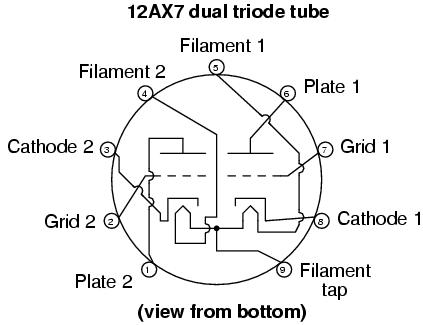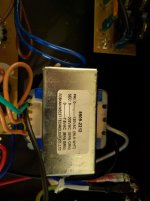Hey guys, new to the forum with a question. I recently purchases a Kustom Defender 5h tube guitar amp and was attempting to wire in a standby switch. While trying to strip the wire to connect the switch one of the secondary wires from the power transformer pulled out. I pushed the wire back into where it came from (assuming it was getting power from induction), but it no longer worked. Desperate, I cut the plastic wrapping to see if it had been soldered in, but the other wires were just wrapped around paper. I put the wire back in like all the other ones, but it still doesn't work. (the lower voltage secondaries (heater circuit) still work correctly as the tubes start warming up)
Am I missing something important here as far as putting the wire back or is the transformer pretty much shot once a wire comes out like that?
I went online to see about a replacement, but I couldn't find it by the part number printed on the transformer or by the voltages. If the original transformer can't be repaired, could someone kindly direct me to where I might be able to find a replacement?
I've attached a picture of the OEM transformer in case that helps. I can take pictures of how the wires are place in the wrapping if that would help as well. Thanks in advance for your help!
Am I missing something important here as far as putting the wire back or is the transformer pretty much shot once a wire comes out like that?
I went online to see about a replacement, but I couldn't find it by the part number printed on the transformer or by the voltages. If the original transformer can't be repaired, could someone kindly direct me to where I might be able to find a replacement?
I've attached a picture of the OEM transformer in case that helps. I can take pictures of how the wires are place in the wrapping if that would help as well. Thanks in advance for your help!
Attachments
Last edited:
Dear burninator,
yes, transformers work by induction - but they need coils consisting of many turns of copper wire for that. The ends of these coils come out of the transformer as leads. Sometimes the (solid) wire of the coils is soldered to flexible pieces of wire for the external connection. Sticking a loose end back in will not work.
In your case, either such a soldered piece of wire came loose, or a length of the original magnet wire broke off. Whatever happened, the corresponding winding of the transformer is rendered useless, it requires a skilled technician and a profound basic knowledge of transformer technology to try a repair.
Get a new transformer and try to handle it with more care next time...
Regards,
Andreas
yes, transformers work by induction - but they need coils consisting of many turns of copper wire for that. The ends of these coils come out of the transformer as leads. Sometimes the (solid) wire of the coils is soldered to flexible pieces of wire for the external connection. Sticking a loose end back in will not work.
In your case, either such a soldered piece of wire came loose, or a length of the original magnet wire broke off. Whatever happened, the corresponding winding of the transformer is rendered useless, it requires a skilled technician and a profound basic knowledge of transformer technology to try a repair.
Get a new transformer and try to handle it with more care next time...
Regards,
Andreas
Dear burninator,
yes, transformers work by induction - but they need coils consisting of many turns of copper wire for that. The ends of these coils come out of the transformer as leads. Sometimes the (solid) wire of the coils is soldered to flexible pieces of wire for the external connection. Sticking a loose end back in will not work.
In your case, either such a soldered piece of wire came loose, or a length of the original magnet wire broke off. Whatever happened, the corresponding winding of the transformer is rendered useless, it requires a skilled technician and a profound basic knowledge of transformer technology to try a repair.
Get a new transformer and try to handle it with more care next time...
Regards,
Andreas
I assumed as much, but the other three leads are not connected to anything, so I thought maybe there was hope :-/
I searched all over for that part number and couldn't find it, any ideas where I could get one or one with the same specifications?
Thanks!
 I think you'll get much more help over in the forum where guitar amplifiers are discussed which is Instruments & Amplifiers. I'll move it there.
I think you'll get much more help over in the forum where guitar amplifiers are discussed which is Instruments & Amplifiers. I'll move it there.In addition the label on your transformer provides a valuable clue for the requirements a replacement transformer would need to meet in order for the amplifier to function as intended.
I assumed as much, but the other three leads are not connected to anything, so I thought maybe there was hope :-/
The three leads were definitely connected to 'something'. I assume you already broke those connections when you cut open the plastic wrapping. Magnet wire for high voltage windings is usually very thin and fragile.
I searched all over for that part number and couldn't find it, any ideas where I could get one or one with the same specifications?
Thanks!
The label on the old transformer gives you the number, voltages and configuration of the required windings. It does not give any currents or wattages. Get an original schematic for the amplifier. While it is possible to deduce these data from the design of the amplifier, this requires some deeper knowledge of tube circuitry.
NOTE: Your general level of electronics knowledge seems not appropriate for work on high voltage tube circuits. Being unfamiliar with basic principles of safely working with high voltages may kill you!
Regards,
Rundmaus
It's not really worth it to install a standby anyway. There is clear evidence from several informed individuals who know what they are talking about that it's not worth the trouble. Besides, if the warranty is in effect, going inside and doing this voids the warranty.
It might be best to contact Kustom for an exact replacement.
Read this: The Valve Wizard
It might be best to contact Kustom for an exact replacement.
Read this: The Valve Wizard
Last edited:
Does this amp just have a single 12AX7 or does it also have something like a 6BQ5 as well? I have the impression it might be a hybrid since in a quick look I found no references to a power tube in the ad copy.
Edit: I found it, the tube complement is one 12AX7A/ECC83 and one 6BQ5/EL84 so simple two tube amp.
https://www.kustom.com/index.php/guitar-amps/defender-series/defender5h.html
I would contact them about a replacement power transformer.
Edit: I found it, the tube complement is one 12AX7A/ECC83 and one 6BQ5/EL84 so simple two tube amp.
https://www.kustom.com/index.php/guitar-amps/defender-series/defender5h.html
I would contact them about a replacement power transformer.
If you are ready to junk the transformer on hand, I would at least take it apart enough to see if you can find where that lead attached, and see if you can solder it back on. Transformers are simple devices.
You're right, I'm not very knowledgeable with tube circuits, just very basic wiring and I thought adding a switch would be easy enough while avoiding working on anything else in there. I screwed up while stripping the end of that lead and now I'm in my mess.... I Feel like an idiot with much to learn :-/The three leads were definitely connected to 'something'. I assume you already broke those connections when you cut open the plastic wrapping. Magnet wire for high voltage windings is usually very thin and fragile.
The label on the old transformer gives you the number, voltages and configuration of the required windings. It does not give any currents or wattages. Get an original schematic for the amplifier. While it is possible to deduce these data from the design of the amplifier, this requires some deeper knowledge of tube circuitry.
NOTE: Your general level of electronics knowledge seems not appropriate for work on high voltage tube circuits. Being unfamiliar with basic principles of safely working with high voltages may kill you!
Regards,
Rundmaus
Sent from my Nexus 6P using Tapatalk
Don't worry, you are in good (bad? ) company.
We have *all* done such things .... and worst of all, will *continue* to 🙁
The basic voltages are reasonable and power (VA) rating can be calculated by transformer dimensions, but I'm quite intrigued/worried at the way too high filament voltage stated in that label.
Normal is 6.3VAC but yours states 7.5VAC ??????????
Since you say that one still works, please measure filament voltage :
6BQ5: from pin 4 to pin 5
12AX7: from pin 4 or pin 5 to pin 9
Measure first using the 20VAC scale on your multimeter and then using the 20V DC one, both ways, because they *might* DC filaments.
Please post results.
Seen from below (from the pins side):


to save time, already measure and post EI lamination dimensions and stacking/thickness which in this case is the sheet metal "rectangle" where the label is glued: length and width.
If possible, in mm 😉
Say (as seen in your picture): 75 mm high x 25 mm wide, but what you actually measure.
We have *all* done such things .... and worst of all, will *continue* to 🙁
The basic voltages are reasonable and power (VA) rating can be calculated by transformer dimensions, but I'm quite intrigued/worried at the way too high filament voltage stated in that label.
Normal is 6.3VAC but yours states 7.5VAC ??????????
Since you say that one still works, please measure filament voltage :
6BQ5: from pin 4 to pin 5
12AX7: from pin 4 or pin 5 to pin 9
Measure first using the 20VAC scale on your multimeter and then using the 20V DC one, both ways, because they *might* DC filaments.
Please post results.
Seen from below (from the pins side):


to save time, already measure and post EI lamination dimensions and stacking/thickness which in this case is the sheet metal "rectangle" where the label is glued: length and width.
If possible, in mm 😉
Say (as seen in your picture): 75 mm high x 25 mm wide, but what you actually measure.
The best apprach is to change the power transformer. It may be repaired, but is a tedious time-consuming work that may not even get the desired results. I have done it to salvage expensive or difficult to replace transformers, but it is not worth the effort for a $20 China import transformer you may find on aliexpress. The label on this kind of cheap transformers may be misleading, they often list odd, higher voltages and power values. I believe that the manufacturer is saving on the copper wire, and the voltage under load suffers a significant drop. If your amplifier follows the most common 12AX7A/ECC83 plus 6BQ5/EL84 tube circuit, check a replacement part for a similar device made by a well-known manufacturer such as Fender. I suggest to spend a little more and select a transformer made by a reputable vendor; the price will be twice that of the cheapest China import transformer but you will have a better product with a longer life and safe operation.
Hammond is a good starting point. Check the www.hammondmfg.com web site and go to the guitar amp replacement transformers section. The 290WX transformer may be a candidate. According to the pdf drawing on the web site, the open circuit ac high voltage secondary is 255v and the filament is 6.9v. That's a good fit for EL84+ECC83. Hammond products are sold trough several online retailers and most electronic components spare part distributors such as Mouser.
Regards,
Paolo
Hammond is a good starting point. Check the www.hammondmfg.com web site and go to the guitar amp replacement transformers section. The 290WX transformer may be a candidate. According to the pdf drawing on the web site, the open circuit ac high voltage secondary is 255v and the filament is 6.9v. That's a good fit for EL84+ECC83. Hammond products are sold trough several online retailers and most electronic components spare part distributors such as Mouser.
Regards,
Paolo
If you are ready to junk the transformer on hand, I would at least take it apart enough to see if you can find where that lead attached, and see if you can solder it back on. Transformers are simple devices.
Thought the same at first, but theburninator wrote that all the wires of the HV secondary were not connected to anything, but wrapped around a piece of paper. I therefore assume that all three wires broke off in the process of removing the plastic tape. Could be difficult to repair, it's thin, coated wire and probably not broken at the solder connection, but a few cm into the winding. I would expect isolation and reliability issues if a repair is tried.
Regards,
Rundmaus
Thanks for all the help guys! Since I was going to throw it away anyway, I took one last look at the transformer and found the lead that had been disconnected. The problem was that I didn't realize the leads were just single strands of copper. Anyway, I was able to successfully solder it back to the output wire and everything seems to work correctly again!
I put everything back together and I don't think I'll be opening that back up until I know a LOT more about tube circuits/etc!
Thanks again!
I put everything back together and I don't think I'll be opening that back up until I know a LOT more about tube circuits/etc!
Thanks again!
- Status
- Not open for further replies.
- Home
- Live Sound
- Instruments and Amps
- Replacement power supply (transformer) for guitar amp, HELP!

